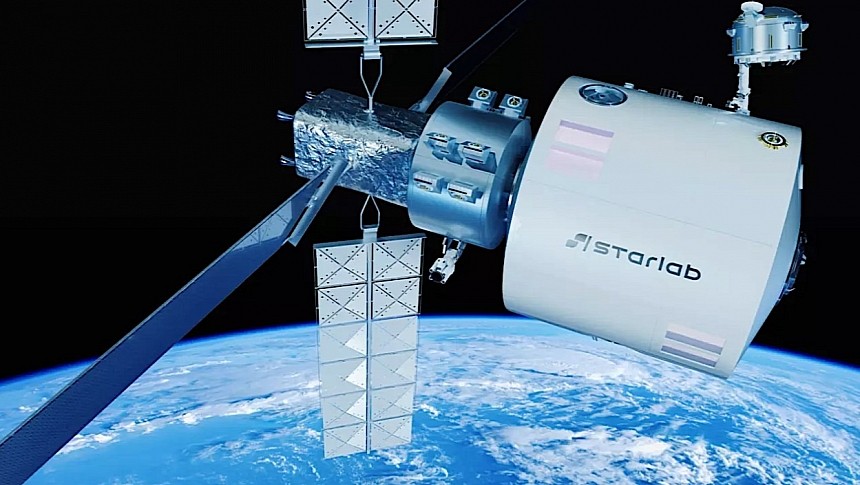The near future will bring with it increased human activity in the space around our planet. And by that I don't mean only an increase in the number of satellites we're sending up there (although that will happen too), but a huge leap in the number of human-rated habitats planned to be built in orbit.
At the time of writing Earth has just two crewed orbital habitats, the aging and soon-to-be-retired International Space Station (ISS) and the Chinese Tiangong. The next decade or so should bring a lot more, most of them privately funded and operated.
That list of future human living spaces in orbit includes something called the Starlab. Planned to be launched in 2028, it should act as the spiritual successor of the ISS, the place where NASA and ESA astronauts can continue to do what they're doing.
To be owned and operated by Nanoracks, Starlab will be placed in low-Earth orbit (LEO) and act as the "first-ever free-flying commercial space station." It will be quite large (not as large as the ISS, though), offering an interior space of 340 cubic meters (12,000 cubic feet) inside an inflatable habitat.
Four people can be housed inside at the same time, and they'll have to divide their time up there working in the biology lab, plant habitation lab, physical science and materials research lab, and an open workbench area.
Despite being smaller than the ISS and allowing fewer people in, Starlab promises to "provide 100 percent of the International Space Station's payload capacity with the ability to conduct hundreds of experiments and technical investigations per year."
Like all other space stations, it will be equipped with a metallic docking node, a power and propulsion element (good for 60 kW), and a robotic arm.
The station is still in its early stages, and a company called Voyager Space is presently chasing interested parties to invest in the project. One of the biggest names to be drawn in is that of Airbus, which back in January got on board as the supplier of "technical design support and expertise for the Starlab space station."
That rather undefined role was expanded significantly this week with the announcement of a joint venture between the European aerospace giant and Voyager Space.
The goal of the unnamed new business is to develop, build, and operate Starlab, making Airbus a much more involved partner in the project. Based in the U.S., the venture will also have a European subsidiary tasked with serving the ESA. Other companies are involved in Starlab as well, with Lockheed Martin for instance acting as Starlab's technical integrator.
The station is still a very long way from becoming a reality, but work is progressing. Earlier in June Starlab reached an important milestone, the completion of the NASA Systems Requirements Review (SRR).
That list of future human living spaces in orbit includes something called the Starlab. Planned to be launched in 2028, it should act as the spiritual successor of the ISS, the place where NASA and ESA astronauts can continue to do what they're doing.
To be owned and operated by Nanoracks, Starlab will be placed in low-Earth orbit (LEO) and act as the "first-ever free-flying commercial space station." It will be quite large (not as large as the ISS, though), offering an interior space of 340 cubic meters (12,000 cubic feet) inside an inflatable habitat.
Four people can be housed inside at the same time, and they'll have to divide their time up there working in the biology lab, plant habitation lab, physical science and materials research lab, and an open workbench area.
Despite being smaller than the ISS and allowing fewer people in, Starlab promises to "provide 100 percent of the International Space Station's payload capacity with the ability to conduct hundreds of experiments and technical investigations per year."
Like all other space stations, it will be equipped with a metallic docking node, a power and propulsion element (good for 60 kW), and a robotic arm.
The station is still in its early stages, and a company called Voyager Space is presently chasing interested parties to invest in the project. One of the biggest names to be drawn in is that of Airbus, which back in January got on board as the supplier of "technical design support and expertise for the Starlab space station."
That rather undefined role was expanded significantly this week with the announcement of a joint venture between the European aerospace giant and Voyager Space.
The goal of the unnamed new business is to develop, build, and operate Starlab, making Airbus a much more involved partner in the project. Based in the U.S., the venture will also have a European subsidiary tasked with serving the ESA. Other companies are involved in Starlab as well, with Lockheed Martin for instance acting as Starlab's technical integrator.
The station is still a very long way from becoming a reality, but work is progressing. Earlier in June Starlab reached an important milestone, the completion of the NASA Systems Requirements Review (SRR).






